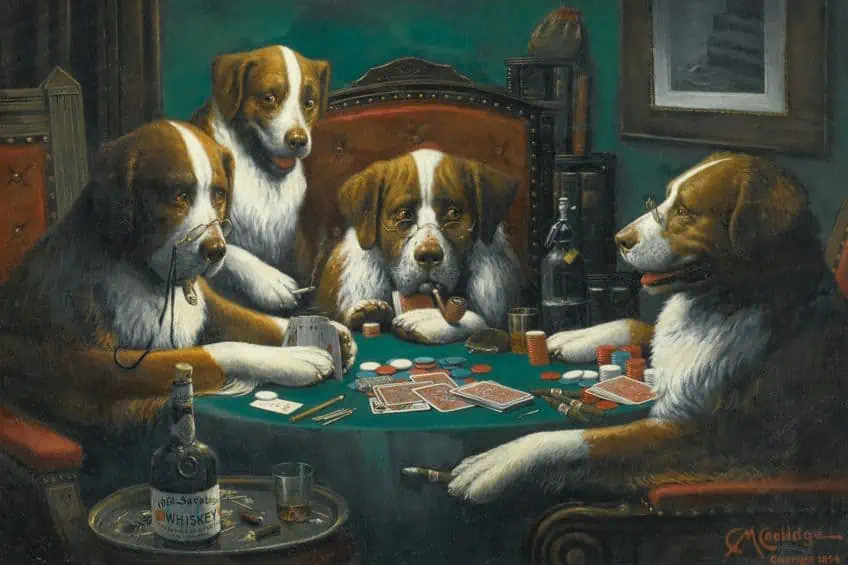“Dogs Playing Poker” by Cassius Marcellus Coolidge – An Analysis
You have most likely seen the image many times before, but have you ever wondered who painted Dogs Playing Poker? Well, there were actually 18 paintings of dogs playing cards produced by Cassius Marcellus Coolidge. There is no actual painting titled Dogs Playing Poker by Cassius Marcellus Coolidge, as this was the collective name given to all of his Dogs Playing Poker paintings as a series. One of the most well-known of these paintings of dogs playing cards was called A Friend in Need, painted in 1903.
Exploring the Series Dogs Playing Poker by Cassius Marcellus Coolidge
These paintings of dogs playing cards have become iconic over the ages in American pop culture, reproduced in a thousand different ways and countless media. Yet, while the public may have embraced these Dogs Playing Poker paintings, they have always been met with derision by the art academic and institutional worlds. For example, the director of the Chrysler Museum of Art in Virginia, William Hennessey, issued a statement to the press on the 1st of April, 2002, stating that he was attempting to obtain the entire series of Dogs Playing Poker paintings.
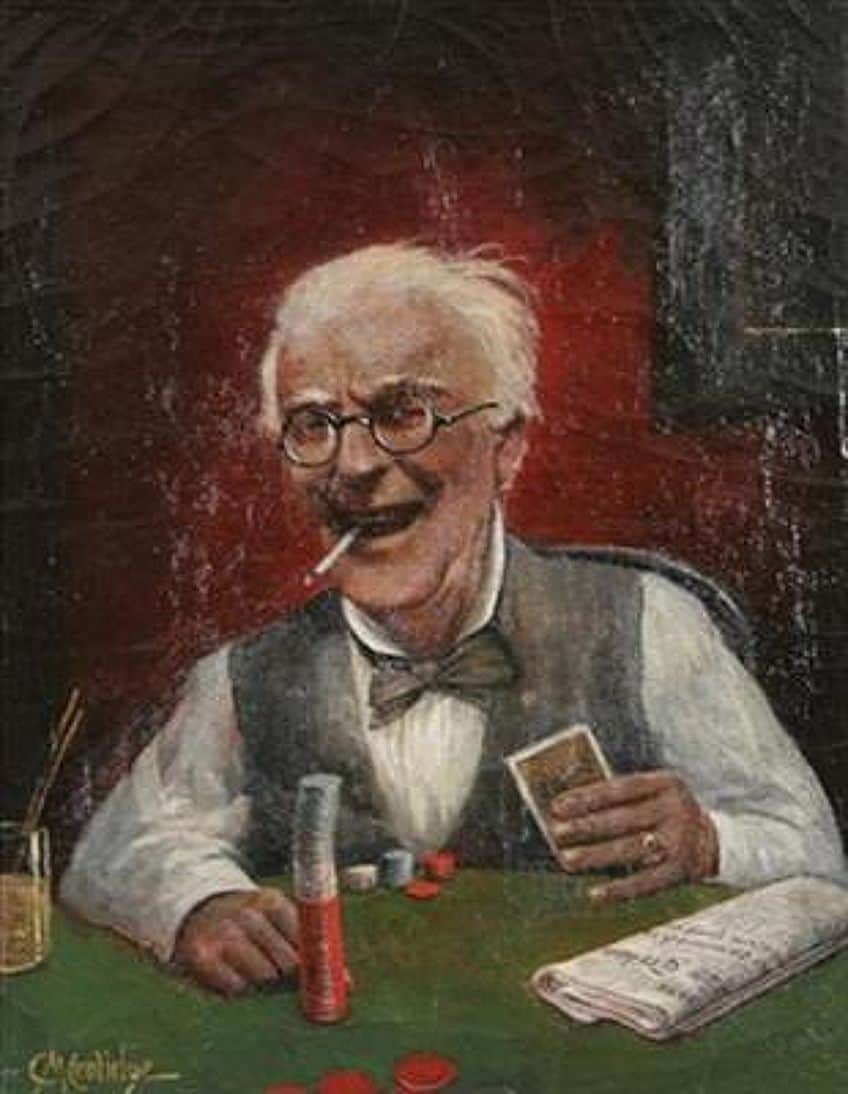
However, the press announcement turned out to be a prank. The thought of exhibiting such a kitsch work of art in a museum was apparently very funny to art historians. Yet, in the same breath as saying that it was a joke, he also admitted that he actually enjoyed these artworks. So, while many may pretend to dislike them, others regard them as something of a guilty pleasure – like a fine dining chef enjoying a Big Mac on his night off. What is it about these saccharine sweet paintings of dogs playing cards that appeal to the sweet tooth of even the most refined palette? Perhaps it is the pleasure that comes with seeing man’s best friend partaking in human activities, or the attention to detail applied to such a frivolous subject matter.
An Introduction to the Artist Cassius Marcellus Coolidge
| Name | Cassius Marcellus Coolidge |
| Nationality | American |
| Date of Birth | 18 September 1844 |
| Date of Death | 13 January 1934 |
| Place of Birth | Antwerp, New York City, United States |
Cassius Marcellus Coolidge remains largely unrecognized to the general public, despite the fact that his Dog Playing Poker paintings have become legendary in pop culture. In the 20th century, he sometimes signed his paintings with the name Kash Koolidge for humorous effect. He was raised near Philadelphia in New York, by abolitionist Quaker farmers. He had practically no professional training as an artist, as was the case with many other American artists. In the early 1860s, he left the family farm and tried to find stable work.
From 1868 to 1872, Coolidge was employed as a druggist as well as a sign painter and even established a bank and a newspaper before relocating to Rochester, New York, where he first began painting dogs in an anthropomorphic manner.
Cassius Marcellus Coolidge is known for being the originator of “comic foregrounds”, which are novelty photos in which the subject holds a canvas in front of them while the artist draws or paints a caricature image of their body on said canvas. The final portrait was created by taking a photo of the image. This evolved into foregrounds pre-painted onto wood with holes through which individuals could stick their heads to provide the appearance that they were the caricatures. These became very popular at carnivals, midways, and amusement parks.
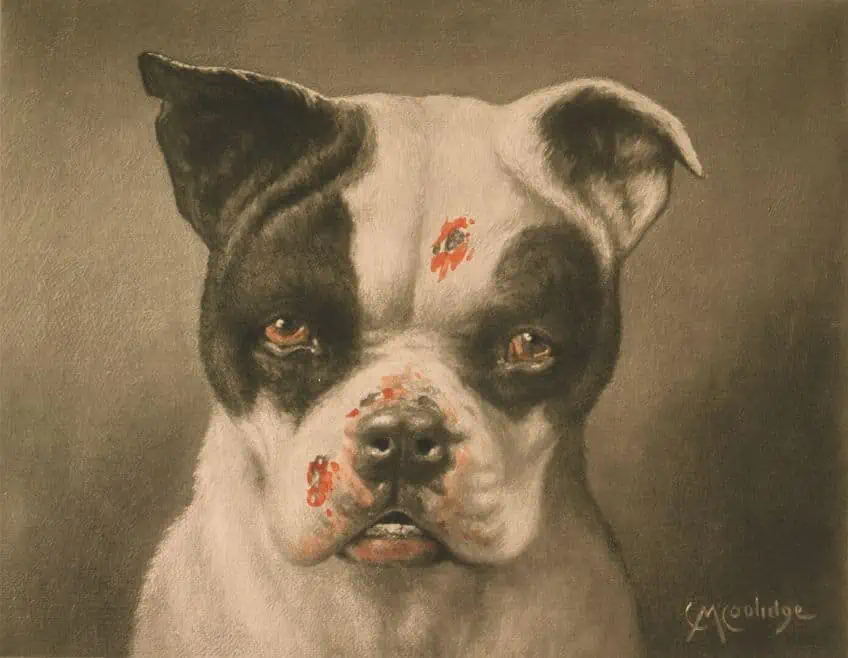
While Cassius Marcellus Coolidge’s paintings are often ridiculed by the art world, they have been known to sell for incredibly high prices. In February 2006, two works of art, Waterloo and A Bold Bluff, were auctioned off collectively for $590,400 at Doyle New York. While his artworks are regularly referenced in mainstream culture, from films to television cartoons, Coolidge’s name is rarely credited as the original artist of the Dogs Playing Poker paintings. Because of the popularity of these works, numerous imitations have been created by inferior artists. Yet, that does not mean that Coolidge’s efforts and talent have gone entirely unrecognized, as his paintings are likely to fetch between $400,000 and $750,000 in today’s market.
The Origins of the Dogs Playing Poker Paintings
Cassius Marcellus Coolidge had a gift for creating delightfully weird, hilarious illustrations that he sold to multiple periodicals despite having no formal training. Coolidge’s talent for creating whimsically surreal artwork culminated in his absurdist dog series for which he is most known today. Poker Game (1894), his first artwork in the series, depicts four dogs engaged in a heated game of cards, with the focus being on a dog deep in thought in the center of the painting, trying to hide his hand. It’s not known what originally inspired these paintings. The composition of the artwork, however, is believed to have been influenced by the paintings of Caravaggio, Georges de La Tour, and Paul Cézanne, all of whom portrayed card-playing scenes – though, with people as the main subject matter, instead of dogs.
Many have drawn comparisons between Coolidge’s paintings and the painting Laying Down the Law (1840) by Sir Edwin Landseer, an English artist.
Both have dogs hanging about pensively, behaving like humans – playing a game of cards in Coolidge’s artwork and acting like attorneys in Landseer’s. Yet, Coolidge’s image conveys a much lighter and more humorous mood than Landseer’s far more solemn and serious atmosphere. The dog depicted on the left of the canvas has Four of a Kind, one of the best hands in several popular versions of the game. This small detail suggests that the artwork is about the moment a great hand is revealed and emphasizes the most exhilarating aspects of a poker game. This artwork sold at a Sotheby’s New York auction in 2015 for $658,000. Various cigar businesses reproduced the Poker Game and included it on their cigar packaging.
The Dogs Playing Poker Painting Series
Coolidge was hired by Brown & Bigelow, a publishing company, to produce his collection of paintings for them around nine years after the original Poker Game painting was produced, in 1903. This 16-piece series illustrates groups of canines in various human activities, such as a road trip, a football game, a jester performing for royalty, and of course, dog playing cards. Only nine of these paintings actually featured dogs playing cards, while the remaining works depicted dogs in other human-like situations. Originally, these paintings were used to promote cigars through calendars, promotional posters, and prints.
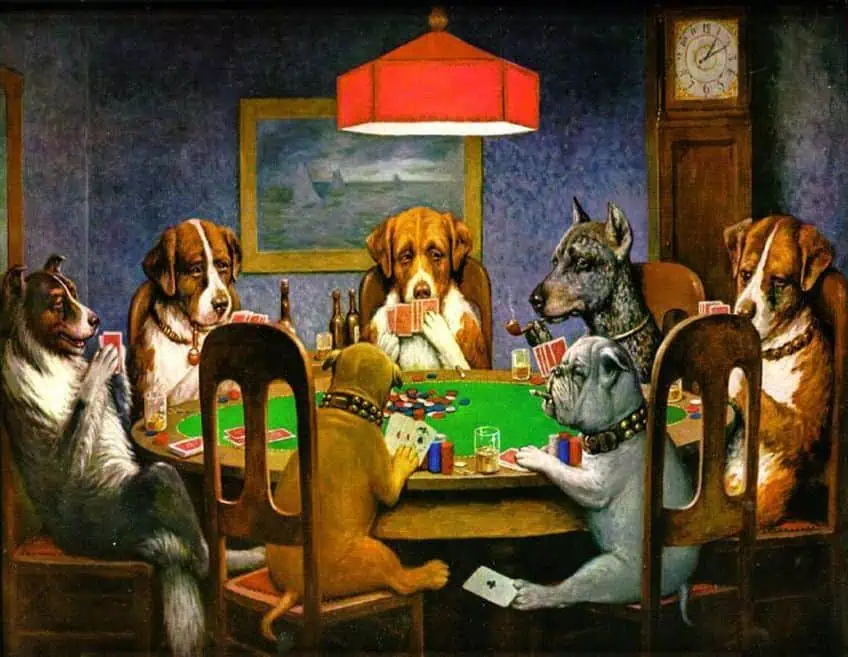
The calendars, particularly, were very popular across the country, and Coolidge’s artwork ended up in millions of households. The most well-known piece in the series is A Friend in Need, which was repeatedly duplicated in calendars selling cigars and was extremely successful. It portrays a dog in the foreground covertly passing an ace to his partner, while his opponents throw side glances around the table. It is far more vibrant than many of his previous paintings and sets a more informal mood of friends playing a game of cards. Although the original painting has never been auctioned, it is estimated to be worth millions of dollars. Maybe it is the artwork’s sly, yet lighthearted representation of deception applied to man’s greatest and most faithful companion that makes it so entertaining.
The Narrative Continues from One Painting to Another
In two of the artworks, A Bold Bluff (1903) and Waterloo (1903), there is a continuous narrative that plays out from one painting to another. A Bold Bluff depicts a group of dogs seated around a poker table, with the Saint Bernard dog holding a particularly bad hand. The painting’s main subject matter is the moment of suspense and anticipation as the Saint Bernard dog attempts to trick the other dogs into assuming that he has a strong hand. The other dogs at the table are watching him intently, trying to determine if he is bluffing and whether they should fold or call his bluff. In the painting Waterloo, the same gang of dogs is depicted at a climactic moment in which the Saint Bernard dog’s deception is discovered and the other dogs around the table respond to it in a number of different ways, including shock, disappointment, and amusement.
Due to the running narrative in these works, they were sold as a pair, setting a new record for Cassius Marcellus Coolidge’s artwork at $590,400.
The Rest of the Dogs Playing Poker Paintings Series
As mentioned before, while the name of the series of paintings produced for the publishing company was called Dogs Playing Poker by Cassius Marcellus Coolidge, not all of them actually featured dogs playing cards, and many of them showed dogs engaged in other human pastimes and activities. The first painting in the series was one we have already discussed, A Friend in Need (1903). It was the first of many other paintings in this series to be created in 1903, with the next being A Bachelor’s Dog. In this painting, we can see what appears to be a Border Collie reclining in a wooden armchair against a plush red pillow. He is portrayed as a typical bachelor of the period, with a cigar hanging from between his jaws and newspapers and mail on his lap. Beside him is another table, on which we can see a glass of beer, a cigar box, loose cigars, books, and a red lamp.
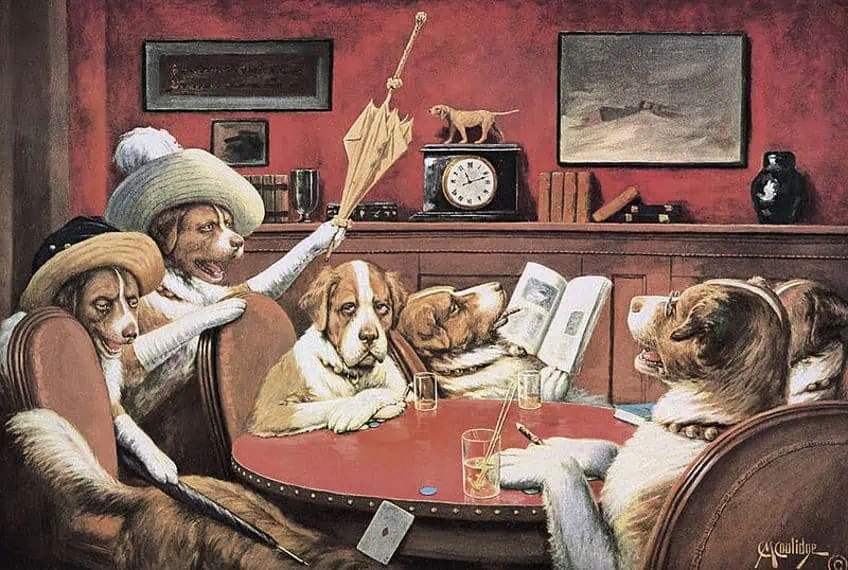
Another painting produced that same year was His Station and Four Aces. In this painting, we see a group of well-dressed dogs playing a game of poker around a table on a train. The bulldog to the left has a hand with four aces and is about to win. However, we see the dog next to him getting up to leave, and a dog enters from the right wearing a train worker uniform, indicating that they are arriving at the next station. The bulldog seems to be shouting out in disappointment, as he realizes he will not be able to play his hand of four aces before they reach his station, hence the name of the artwork. In Pinched with Four Aces, the poker tables have suddenly turned when four dogs dressed as policemen storm into the smoky room of poker players from the right. The emotions on the dog’s faces as they get raided range from anger to surprise, contempt, and fear. The dog at the bottom of the painting specifically, looks like it has just been caught eating Christmas dinner, and is trying to coyly slink off the chair and away from the police dogs. The next of these paintings to be produced in 1903 was Poker Sympathy, which seems like a bit of an oxymoron.
Whereas sympathy requires a display of compassion, poker faces are traditionally non-emotive. In this painting, it appears as if one of the dogs lost the round with a bad hand and threw his cards from the table, spilling a drink in the process. Rather than showing any sympathy, the rest of the crowd seems to be jeering at him, with the winning dog laughing hysterically. Perhaps that is as much sympathy as one can expect in a dog-eat-dog poker game! Next up is Post Mortem (1903). In this painting, we can see three dogs seated at a poker table in a den. The table is full of drinks, food, and pipes, and the cards are all packed neatly together in a stack. The dogs seem to be engaged in deep conversation. Perhaps they are talking about the day’s important issues before playing a game, or perhaps they are discussing their gameplay after they have completed their game, providing a “post-mortem” of either the game or the day. In Riding the Goat (1903), we see a move away from the theme of dogs playing poker. This painting has been interpreted in a couple of ways, with one being a jester entertaining royalty, and the other being a symbolic representation of a Masonic ritual.
It depicts a Saint Bernard dog riding on a goat blindfolded. The blindfold is also a significant feature of the first three degrees of Freemasonry, each with its own symbolic meaning.
After that brief move away from the topic of poker, Coolidge then returned to it again in Sitting Up With a Sick Friend (1905). Based on the title of this work, these dogs had gathered at a friend’s house to smoke cigars, drink alcohol, and play poker under the guise that they were going to go keep a sick friend company. However, their idyllic scene has been interrupted by two female dogs donning hats, long white gloves, and umbrellas storming the room and foiling their ruse. The male dogs all react in a different way to the unexpected intrusion, with one running away, and the others looking surprised or dejected.
In 1906, he once again moved away from the topic of dogs playing cards with the creation of Ten Miles to a Garage. A family of dogs is on its way to a picnic on a beautiful Summer’s day when their car breaks down on a lonely rural road. They’re most likely in rural New York, based on the state indicated on the car’s license plate. The little puppies run around the car sporting bonnets and clutching food baskets, while the majority of the adult canines attempt to fix the vehicle. However, in typical human fashion, just one dog has gone beneath the car and is actively working, while the rest of the dogs wait around. Some of the adult canines take advantage of the unplanned break to smoke a cigarette.
Also produced in 1906 was One to Tie, Two to Win. No matter the context, Coolidge seemed to enjoy portraying climatic moments in many of his works, and this one is no exception. As you can tell from the title, this work portrays an exciting moment in baseball where the outcome is about to be determined by the subsequent gameplay. The dogs are all standing up in their chairs in excitement, with many dogs even cheering from their position on the stadium’s roof. On the field itself, we can see a dog somehow holding the bat without thumbs, waiting for the pitcher to deliver the ball.
Yet another departure in the series from the usual theme of dogs playing poker is New Year’s Eve in Dogsville (1907). In a massive ballroom, there is a vast array of canine characters. The dogs are celebrating the start of a new year. The majority of the couples in the front appear to be enthusiastically enjoying each other’s embraces, but a bulldog in the distance is dancing with his partner and has a look of complete dread on his face. All of the tables are brimming with wine and champagne, and a band positioned on the top right-hand side provides entertainment for the evening. Despite its humorous theme, the work does display Coolidge’s talents and abilities to paint background architecture and details such as light illumination and reflections on the surface of the floor.
The next painting, Breach of Promise Suit (1909), depicts a rather more somber subject matter, yet still features dogs performing as the main characters. This work in the series depicts a court case involving a broken marriage pledge. In those days, when a man became engaged, sometimes after enticing a lady, but subsequently changed his mind and didn’t marry her, he had to partake in a common law cause of action. Maybe the bulldog in front of the crate committed itself to the Boston Terrier making her argument before the court in this case. Letters, photographs, and jewelry lay on the ground to the judge’s right, most likely as evidence in the case. This seduction may have even resulted in the puppies on the far left. The courtroom audience is watching this soap opera unfold with bated breath.
Canine fur trappers play cards near a campfire in Stranger in Camp. If you examine the poker hands carefully, you will discover that the dog on the right has four aces. Yet, the dog on the left has a straight flush, defeating the other excellent hand. The stunned expression on the losing dog’s face, with his huge eyes and fallen jaw, is quite extraordinary. In addition, the victorious dog is snidely laughing. A dog cooks meals over an open fire in the background, as raccoon skins dry spread over tree trunks. A fishing pole and guns are also propped up against a tree. A group of six canines is depicted having fun playing a game of pool around a billiards table in Kelly Pool.
The remaining five dogs are constantly pestering the shooter in an attempt to put him off his game.
The Popularity of Dogs Playing Poker by Cassius Marcellus Coolidge
Despite the fact that Cassius Marcellus Coolidge is still largely unknown as an artist, having been termed “the most popular American painter you’ve probably never heard of”, his works are instantly identifiable to individuals of every generation. According to a 1973 article from American Heritage, “Coolidge’s poker-faced approach is still entertaining today. His expressions, attire, and furnishings are all accurately rendered. The sincere animals are uncannily similar to individuals we all know”. Yet in the art world, these works are often referred to as kitsch.
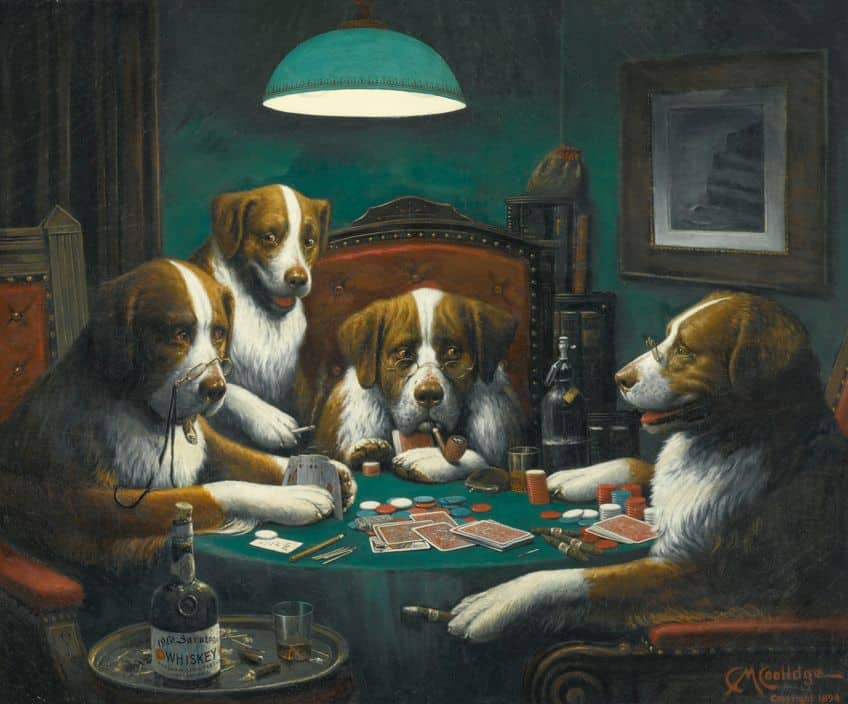
According to Poker News, “For some people, these artworks reflect the very definition of lowbrow or kitsch culture, a poor-taste imitation of ‘actual’ art”. Others have suggested that the Dogs Playing Poker paintings were a satirical series designed to parody the upper class in their attitudes and excesses. A framed reproduction of one of Coolidge’s pieces from his private collection hangs at a small museum at the back of the town library in Philadelphia, where the artist was raised. Gertrude Marcella, his then-80-year-old daughter, gave it to the community in 1991. Since their inception, the artworks have appeared in a variety of films, television shows, songs, cartoons, plays, and artworks.
Brown & Bigelow is still in business and continues to sell Coolidge prints on the internet.
Why Are the Dogs Playing Cards Paintings Regarded As Kitsch?
Kitsch art is popular because it evokes emotional or nostalgic sentiments. These paintings depict whimsical and hilarious situations of dogs engaged in human-like activities, which could evoke an emotional or nostalgic response. Kitsch art is often popular and appealing to a large audience. These dogs playing cards paintings were extremely popular at the beginning of the 20th century and have since become very popular and copied in a variety of media, including calendars, posters, and commercials.
Their popularity and extensive distribution also contribute to their kitsch reputation. Kitsch art tends to take on a lighthearted or comical tone. In this series of paintings, the anthropomorphic image of dogs playing poker is undoubtedly imaginative and puts an amusing spin on human pastimes, contributing to the overall kitsch aesthetic. However, it’s important to note that while many people may use the words in a derogatory manner, there are also many people who love the aesthetic and intentionally seek out kitsch art and furniture.
That brings us to the end of this article on Dogs Playing Poker by Cassius Marcellus Coolidge. While the theme of dogs playing poker and partaking in other human activities might seem kitsch and even juvenile to some people, it is clearly evident that many truly love these paintings. While they may not have ended up hanging in renowned museums, they did end up gracing many living rooms of American homes – perhaps the real testament to their popularity and status. No matter how the Dogs Playing Poker paintings are perceived by the academic art world, they have won their place in the hearts of millions of people around the world.
Frequently Asked Questions
Who Painted Dogs Playing Poker?
Dogs Playing Poker was not actually a single painting, but rather a series of paintings. They were produced by Cassius Marcellus Coolidge from 1894 to 1910. While they were collectively known as the Dogs Playing Poker paintings, there were many works in the series that featured other human pastimes, such as dancing, baseball, and riding a car. What they all featured in common was that the main characters were all played by dogs instead of humans – albeit anthropomorphic dogs. While the artist himself has remained rather unknown, his works have become very popular in American culture throughout the years and still feature in pop culture today. Despite his relative obscurity, his paintings still fetch hundreds of thousands of dollars at auction.
What Inspired the Dogs Playing Cards Paintings?
Coolidge created his series of paintings for a publishing company that advertised cigars. However, before the series was created, he had already painted a picture of this very subject, titled Poker Game, in 1894. It was due to the popularity of this painting that the company commissioned him to paint a whole series around nine years later. It is believed that he was inspired by other paintings of the same topic which featured humans, such as those created by artists like Caravaggio. Out of the entire series, only nine actually feature dogs playing cards.
Jordan Anthony is a Cape Town-based film photographer, curator, and arts writer. She holds a Bachelor of Art in Fine Arts from the University of the Witwatersrand, Johannesburg, where she explored themes like healing, identity, dreams, and intuitive creation in her Contemporary art practice. Jordan has collaborated with various local art institutions, including the KZNSA Gallery in Durban, the Turbine Art Fair, and the Wits Art Museum. Her photography focuses on abstract color manipulations, portraiture, candid shots, and urban landscapes. She’s intrigued by philosophy, memory, and esotericism, drawing inspiration from Surrealism, Fluxus, and ancient civilizations, as well as childhood influences and found objects. Jordan is working for artfilemagazine since 2022 and writes blog posts about art history and photography.
Learn more about Jordan Anthony and about us.
Cite this Article
Jordan, Anthony, ““Dogs Playing Poker” by Cassius Marcellus Coolidge – An Analysis.” artfilemagazine – Your Online Art Source. June 12, 2023. URL: https://artfilemagazine.com/dogs-playing-poker-by-cassius-marcellus-coolidge/
Anthony, J. (2023, 12 June). “Dogs Playing Poker” by Cassius Marcellus Coolidge – An Analysis. artfilemagazine – Your Online Art Source. https://artfilemagazine.com/dogs-playing-poker-by-cassius-marcellus-coolidge/
Anthony, Jordan. ““Dogs Playing Poker” by Cassius Marcellus Coolidge – An Analysis.” artfilemagazine – Your Online Art Source, June 12, 2023. https://artfilemagazine.com/dogs-playing-poker-by-cassius-marcellus-coolidge/.


